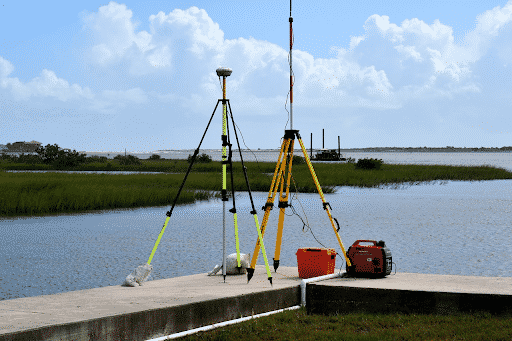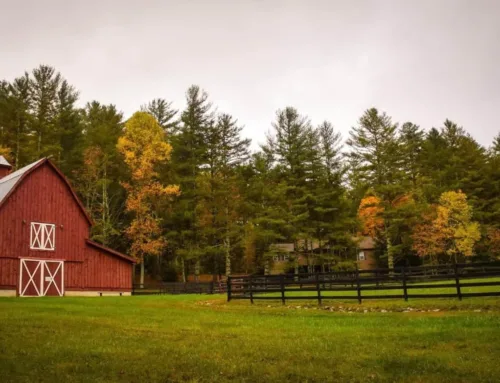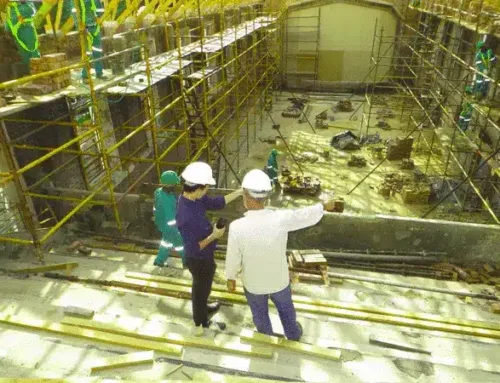Due diligence is a term commonly used in the commercial real estate industry to denote the process of research, discovery and disclosures relating to purchasing or investing in a property. ALTA Land Title Surveys play a vital role for multiple stakeholders in commercial real estate transactions, and the highly detailed requirements for performing an ALTA land survey set it apart from a traditional boundary, border or simple location survey.
ALTA land surveys represent the highest standards in the land surveying industry. Legal, title, development, finance and design professionals all rely on ALTA Land Title Surveys. Over time, many lenders for commercial property acquisitions and new development are requiring ALTA land surveys prior to providing financing.Millman National Land Services offers survey services nationwide and have become the country’s leading direct provider of ALTA Land Title Surveys. Now we’re here to tell you all about ALTA land surveys.
Related: Detailed Zoning Reports and ALTA Surveys
National standards set ALTA land surveys apart
An ALTA land survey begins with an owner commissioning a survey from a qualified land surveyor. One of the fundamental differences between ALTA land surveys and other types of surveys is that ALTA land surveys adhere to national standards known as Minimum Detail Standard Requirements established by both the American Land Title Association and the National Society of Professional Surveyors.
Required and optional survey elements
A number of elements that are crucial to mitigating risks, such as encroachments and unrecorded easements, differentiate an ALTA land survey from less detailed types of surveys. Some of the required elements noted in the ALTA land survey include:
- Boundary lines, including lines that may be hidden or obscured by natural features like streams, trees and brush
- Location of structures on the site
- Encroachments
- Water features
- Easements, including unrecorded easements
- Location of utility lines and points of connection
- A plat or map showing boundaries and any new information recorded in the process of preparing the survey
Optional items for a survey are included in Table A. Table A items must be selected by the party commissioning the survey. Some table items, like delineating the flood zone for the property, are likely to be required by a lender.
One specific change that occurred with the February 2016 update for ALTA land surveys is that the burden of providing zoning analysis was shifted from the surveyor to a certified zoning specialist. In order for Table A optional zoning items to be included in a report, the owner must furnish the surveyor with a report or analysis from a third-party expert.
Need a zoning report? Millman National Land Services can help
A Primer on the ALTA/NSPS Land Title Survey, Table A
An ALTA/NSPS Land Title Survey provides a base report that has copious detail relating to site boundaries, encroachments, easements, utilities and other salient details with regard to land parcels.
With the 2016 changes enacted for the new ALTA survey, some items, such as the evidence of utilities, have been moved to the base report, but there are still multiple optional items that can be included in the supplementary Table A.
Important Table A items
There are 21 discretionary items, and we will discuss some of the most important.
Item 1-Monuments: Setting new monuments is optional, but this is a minimal cost item that can provide clarity with regard to any existing monuments.
Item 3-Flood Zone Classification: It is advisable to select this item to determine whether flood insurance is required.
Item 4-Gross Land Area: If a buyer is contemplating new construction, requesting the land area and square footage of improvements can be important. This information also dovetails with optional zoning elements in items 6(a) and 6(b) of Table A.
Item 6-Zoning: The aforementioned items 6(a) and 6(b) are essential if new construction is planned for a site. If a lender is involved in the project, it will almost certainly require these items. With the new 2016 update, an ALTA surveyor is not required to provide a zoning opinion. If Table 6(a) and 6(b) items are requested, the party commissioning the survey must provide the surveyor with a zoning report or a zoning letter provided by an expert.
Item 8-Substantial Features: This item pertains to property improvements and features outside of the principal buildings on the site. These include service buildings, sheds, swimming pools, areas that have significant landscaping and refuse collection areas. Understanding and defining secondary structures and features on a site can impact valuation significantly.
Item 11-Location of Utilities: While evidence of utilities has been moved to the base report in accordance with the 2006 update, location of underground utilities and equipment is an optional item. As with zoning items in 6(a) and 6(b), item 11 should be a part of any survey prior to new construction.
There are other elements in Table A that need to be reviewed by owners and lenders. Not all of them are pertinent in every situation, but understanding how these can affect a land purchase or new project is quite important.
Related: ALTA Land Survey Process and Overview
ALTA Surveys have strict standards
Compared to other types of surveys, like boundary and as-built surveys, ALTA Surveys are required to provide extensive detail that has been determined to be needed by attorneys, title professionals and lenders. The minimum standard details requirements for ALTA/NSPS Land Title Surveys were last adopted in February of 2016 and require the delineation and notation of the title matters affecting the property, along with many other mandatory and optional items such as::
- All boundary monuments found during the fieldwork.
- Rights of way and access to public streets and highways or private ways.
- Lines of possession and improvements along the boundaries.
- Buildings on the surveyed property.
- Easements, Cemeteries, Water Features
- All observed utilities at the site.
- Optional items include zoning, flood zone classification, parking count, size and height measurements, underground utilizes, wetland and offsite easements.
Millman National Land Services provides ALTA Surveys and Zoning Compliance Reports to clients nationwide, including REITs, private equity firms, law firms and developers. We retain our own staff of surveyors to ensure impeccably high standards, and we invite your inquiries and questions.
At Millman National Land Services, we retain our own staff of surveyors to ensure impeccably high standards, and we invite your inquiries and questions. That’s because when it comes to ALTA Surveys, it’s not only the documents themselves that have a lot of strict requirements. The surveyor themself must be qualified to perform the survey and that means there’s a lot you need to know about ALTA surveyors, too. We have some of that information for you here.
Need help surveying a land? Millman National Land Service can help
Who is qualified to perform an ALTA land survey?
A professional land surveyor who has a seal and license number is qualified to perform an ALTA land survey. While the survey must comply with state laws, an ALTA land survey must also adhere to the report standards established by ALTA. ALTA land surveys are commonly required by lenders and title insurers involved in the acquisition, development and refinancing of commercial properties.
ALTA land surveys are all performed to a very high standard, and since experience for individual surveyors varies quite a bit, it is important to determine the level of experience for your field surveyor. It is also advisable to hire an ALTA land surveyor who has knowledge of regional and local land use practices and can provide insight into potential risks associated with the acquisition or development of a site.
Millman National Land Services provides ALTA land surveys and zoning compliance reports to clients nationwide, including REITs, law firms and developers. We retain our own staff of surveyors for ALTA Land Title Surveys, and we invite your inquiries and questions.
Related: ALTA/NSPS Land Survey and Wetlands Standards
Who performs ALTA land surveys?
The American Land Title Association (“ALTA) and the National Society of Professional Surveyors (“NSPS”) revised the minimum standards for ALTA/NSPS land title surveys (“ALTA Surveys”) in 2016. An ALTA Survey is, in effect, a combination of a boundary survey, an as-built survey and a title survey. Accepted in all 50 states, an ALTA Survey represents the highest standards in the industry.
Many lenders, attorneys and commercial real estate buyers will only consider using an ALTA Survey for due diligence decisions relating to an acquisition or mortgage on a parcel of land. Only a professional land surveyor can prepare an ALTA Survey.
A professional land surveyor will also strictly adhere to state laws with regard to completing ALTA Surveys. ALTA Surveys are widely considered to be the most detailed and comprehensive form of land survey for the commercial real estate market.
Are all surveyors qualified to perform an ALTA survey?
Many real estate and legal professionals involved with land projects are familiar with an ALTA/NSPS land title survey. The organizations established new standards for these surveys in February 2016, but not all clients of ALTA surveys are familiar with the educational, professional and licensing requirements for the surveyors who perform the surveys. The course work, internship process and licensing procedures required to become a professional surveyor qualified to perform an ALTA survey are quite rigorous.
Although there are some interstate variations in terms of the specific educational requirements, individuals who hope to take the NCEES (National Council of Examiners for Engineering and Surveying) fundamentals exam must complete a four-year, or in some cases a two-year, curriculum culminating in a B.S. degree that is comprised of relevant coursework approved for licensure.
After passing the fundamentals exam, a professional surveyor candidate must serve a four-year internship prior to becoming qualified to take the principles and practices exam.
Progress and classification
After passing the fundamentals exam,the industry refers to a fledgling surveyor as either a surveyor intern or a surveyor-in-training. People in this category are not permitted to perform the services of a licensed surveyor. Only individuals who also complete their internships and pass the principles and practices exam may perform an ALTA survey.
ALTA Surveys are performed by trained professionals
There are four broad components to an ALTA Survey: research, fieldwork, drafting and revision. Depending on the complexity of the assignment the entire process can be typically performed in 2 to 3 weeks. When shorter time periods are needed, only larger staffed companies deploying the most recent technology and equipment should be engaged.
Millman National Land can provide you with the best ALTA survey solution
Experience is important when selecting an ALTA surveyor
While ALTA Surveys are all performed to a very high standard, the amount of experience of the individual surveyor performing your survey can vary widely. For this reason, it is advisable to hire an ALTA surveyor who has extensive knowledge and experience in ALTA Surveys and commercial real estate closings. Many local land surveyors perform other types of surveying such as residential surveys, construction staking, oil and gas surveying and may only perform ALTA Surveys on occasion.
Millman National Land Services is a national firm with a local presence. With offices throughout the U.S., we bring local knowledge and experience to your project.
Credentials
When contracting for an ALTA survey, it is essential to confirm the credentials of the surveyor who will be performing the work prior to the beginning of the assignment. The exact nomenclature for surveyors varies depending on the state. Some common titles include:
- Registered Professional Surveyor
- Registered Professional Land Surveyor
- Professional Surveyor
- Professional Land Surveyor
Each state also has its own regulations pertaining to surveyor qualifications, so it is important to corroborate that the surveyor being hired also conforms to state laws. After gaining a license, surveyors must also adhere to continuing education requirements. Advancements in technology and equipment have made this more important than ever.
So now you know what is required in an ALTA Survey and what qualifications a surveyor must have. But now you might be wondering, when do you need to even use an ALTA survey? Don’t worry, we have that covered, too.
Who Needs to Use ALTA Surveys?
Many different parties can use an ALTA survey for their benefit. Title Insurance companies, attorneys, lenders and developers are the four professional constituencies that are most likely to use a survey.
Broadly used to evaluate an investment in land, an ALTA survey is an essential tool for the design of structure to be built on land, and to validate the viability of a project from the standpoint of a lender.
Related: ALTA Surveys and Appurtenant Easements
ALTA/NSPS Surveys for commercial transactions
An ordinary boundary survey may suffice for a property owner if there is no lender involved in the transaction. However, if a lender and a title company are involved, it is likely they will require an ALTA Survey.
Not only does an ALTA Survey indicate boundaries, but it also divulges survey risks. Title companies will generally require an ALTA Survey prior to issuing coverage to a property owner. Survey risks include encroachments, boundary line disputes, easements and claims that may not be indicated in a survey of public records.
It is often non-recorded risks that present the greatest potential threat to an acquisition. An ALTA Survey can be an essential tool for an owner and a lender to determine whether to proceed with an acquisition or a loan.
Commercial property lenders use ALTA Surveys to ensure value, correct zoning, and the conformation of any development with the corresponding zoning. Since an ALTA Survey adheres to common standards, it provides an excellent foundation for all parties who are engaged in the due diligence effort for an acquisition or new development.
Timing for an ALTA Survey
While many lenders will elect to have an owner commission an ALTA Survey prior to funding an acquisition or construction loan, the completed survey is just as important at the end of the project to ensure compliance with applicable zoning laws. Also, having the survey done or revised once a project is complete can ascertain whether there have been any deviations from the engineering or architectural plans.
At Millman National Land Services, we provide ALTA Surveys and other services to ensure that owners, lenders, title companies and attorneys have the confidence that their investments are protected. We invite your inquiries and look forward to serving you with our in-house professional staff.
ALTA Surveys and Appurtenant Easements
While most of the changes included in the 2016 ALTA/ASCM Minimum Standard Detail Requirements update are reasonably straightforward, some require a bit more clarification. One topic that needs some explanation is the way an ALTA survey treats the topic of appurtenant easements.
Derived from the Anglo-French word “apurtenir,” meaning “to belong,” an appurtenant easement runs with the land. An easement can either benefit or burden a property. For example, a landlocked parcel may not have access to a public road except through an easement that would benefit that parcel but burden adjacent landowners. This particular type of easement is referred to as an “easement by necessity.”
Part of the survey’s optional Table A (item 19), appurtenant easements – also known as offsite easements – are required to be disclosed if the surveyor is provided title work that discloses those easements. Since this is an optional item, a survey client must specifically elect to have appurtenant easements disclosed.
As in the 2011 Standards, both the benefits and burdens of appurtenant easements must be disclosed according to the 2016 Standards. The principal difference relates to wording and scope.
In the 2011 standards, appurtenant easements relating to improvements and monuments placed are denoted. In the 2016 revision, the language is clear with regard to disclosure of all offsite easements that benefit or burden the property.
Contact Millman National Land for the best ALTA survey solution
Combining Table A items
From a practical standpoint, the disclosure of appurtenant easements in Table A Item 19 can be combined with other ALTA survey elements, including Table A Item 1, which requires the placing of monuments at the corners of the appurtenant easement. Combining Table A Item 19 with Item 8 requires all the substantial features of the easement to be disclosed. These elements can include signage, pools, landscaped zones, and refuse collection areas. Incorporating Item 11 in Table A will require denoting the location of above ground utilities on the appurtenant easement.
Millman National Land Services performs ALTA/NSPS Land Title Surveys to the highest standards through a dedicated, in-house staff. We invite your inquiries about your specific survey needs.
Since ALTA Surveys are always changing, you must stay on top of the requirements if you want to ensure your survey meets these ever-changing standards. Below, we will outline some of the recent changes to ALTA survey requirements.
Recent Changes to ALTA Survey Requirements
Many of the changes for the new ALTA Survey require additional detail, but the requirements for a surveyor to provide zoning information have actually become less restrictive.
As part of the 2016 new ALTA survey standards, if a client elects to include optional zoning information for Table A item 6, a zoning expert must provide the surveyor with a zoning report or a zoning letter. The most comprehensive type of report is a commercial zoning report, which is something entirely different from a survey.
Detailed zoning reports are vital for land transactions
The overall intent is for the surveyor not to have the burden of providing a client with zoning advice or consulting. However, detailed zoning information is essential for any acquisition or land development project and should be as accurate as possible.
Detailed zoning reports not only convey vital information relating to land use and adherence to municipal codes, but lenders often require them prior to providing financing for an acquisition or new development.
Relying on public records for the compliance status for existing structures can be risky, since there is no assurance that all the improvements have been entitled or are conforming. Zoning is a specialized field of expertise, and only land use attorneys or consultants who specialize in land use are qualified to produce a commercial zoning report.
The changing nature of zoning codes
Assessing zoning for new projects can be complex, particularly since many municipalities continually update their codes, and many districts around the country are now included in special overlay districts that include density bonuses, use restrictions and special requirements relating to parking, mass transit and other ancillary requirements.
Related: A Primer on the ALTA/NSPS Land Title Survey, Table A
Table A and zoning information
If a client provides zoning information to a surveyor, it must be included in Table A item 6 of the report. The zoning information in Table A item 6(a) denotes essential zoning information, including:
- Table of current zoning municipal requirements.
- Copy of current certificate of occupancy.
- Conforming status as provided by the municipality.
- Outstanding violations for zoning, fire and building codes.
- Zoning maps and indication of special overlay districts.
- Zoning designations for neighboring properties.
- Notice of applicable variances/special permits/exceptions/conditions.
- Information relating to setbacks, height restrictions, parking requirements, lot coverage and curb cuts/site circulation.
- Indication of any nonconforming uses.
In item 6(b) a surveyor must graphically depict any setback requirements that relate to the zoning report but only if a third-party zoning expert provides it.
In instances where there is a non-conforming use, lenders will generally require a damage threshold that limits their exposure with regard to reconstructing and/or eliminating the project elements to bring a property into conforming use status.
For many owners and lenders the specter of adverse legal action is the single greatest risk involved with a prospective transaction. Mitigating risk through a meticulously prepared zoning report is highly advisable when it comes to preparing an ALTA/NSPS land title report.
Millman National Land Services provides customers with meticulously detailed ALTA/NSPS land title surveys. We can advise you about what you need to know about zoning for your acquisition, along with other pertinent issues relating to performing a survey tailored to your specific needs.
ALTA Surveys and Appurtenant Easements
While most of the changes included in the 2016 ALTA/ASCM Minimum Standard Detail Requirements update are reasonably straightforward, some require a bit more clarification. One topic that needs some explanation is the way an ALTA survey treats the topic of appurtenant easements.
Derived from the Anglo-French word “apurtenir,” meaning “to belong,” an appurtenant easement runs with the land. An easement can either benefit or burden a property. For example, a landlocked parcel may not have access to a public road except through an easement that would benefit that parcel but burden adjacent landowners. This particular type of easement is referred to as an “easement by necessity.”
Part of the survey’s optional Table A (item 19), appurtenant easements – also known as offsite easements – are required to be disclosed if the surveyor is provided title work that discloses those easements. Since this is an optional item, a survey client must specifically elect to have appurtenant easements disclosed.
As in the 2011 Standards, both the benefits and burdens of appurtenant easements must be disclosed according to the 2016 Standards. The principal difference relates to wording and scope.
In the 2011 standards, appurtenant easements relating to improvements and monuments placed are denoted. In the 2016 revision, the language is clear with regard to disclosure of all offsite easements that benefit or burden the property.
Millman National Land Services have experienced staff of urban planners, environmental planners, attorneys, title examiners, surveyors, and researchers.
Combining Table A items
From a practical standpoint, the disclosure of appurtenant easements in Table A Item 19 can be combined with other ALTA survey elements, including Table A Item 1, which requires the placing of monuments at the corners of the appurtenant easement. Combining Table A Item 19 with Item 8 requires all the substantial features of the easement to be disclosed. These elements can include signage, pools, landscaped zones, and refuse collection areas. Incorporating Item 11 in Table A will require denoting the location of above ground utilities on the appurtenant easement.
Millman National Land Services performs ALTA/NSPS Land Title Surveys to the highest standards through a dedicated, in-house staff. We invite your inquiries about your specific survey needs.
The ALTA survey and evidence of utilities
A subtle but important shift in the base standards established in February 2016 for the new ALTA/NSPS (American Land Title Association/National Society of Professional Surveyors) survey relates to how the evidence of utilities is treated.
Prior to adopting the new standards, surveyors were not required to show evidence of utilities as part of their base study. Previously, a client had to select evidence of utilities as an optional item denoted in Table A item 11(a).
For the new ALTA survey a surveyor must show evidence of utilities as part of the base report. This information is now located in section 5.e.iv. Table A item 11(a) is still available as an optional item, and it comprises a greater level of detail than section 5.e.iv.
Considerations for electing to include Table A item 11 and in an ALTA Survey
For the new ALTA survey the information noted in the old Table A item 11(a), principally noting the evidence of utilities, has been moved to the base report. Item 11 in Table A of the 2016 report is similar to the old Table A item 11(b). Item 11 provides a deeper look at property elements like evidence of rail crossings, underground vaults and cabling infrastructure.
For basic evidence of utilities, the boilerplate information should suffice for most clients. ALTA Survey requirements note that a surveyor must note evidence of utilities like water, sewer, gas and electric running on, above or beneath the property. In addition, the surveyor must indicate markers like sewer hole covers, utility poles, valves, meters and transformers.
For new construction or significant renovation projects, a client may want the additional detail provided in Table A item 11. Item 11 provides a much deeper understanding of the utilities present on the site, including a requirement to call 811 numbers and have utility companies provide information to the surveyor.
At Millman National Land Services, we look forward to providing you exemplary service with regard to your ALTA survey needs and specific project requirements.
Related: Are all surveyors qualified to perform an ALTA survey
ALTA land surveys: The gold standard
With recent updates requiring more detailed information in ALTA/NSPS land surveys, the “gold standard” for professional surveys has been strengthened even further. Far more than a boundary survey, an ALTA land survey requires a wide range of important site information to be included as part of the base report.
In addition to showing basic property boundaries, an ALTA land survey must include:
- Basic zoning information
- Roadways
- Evidence of utilities on site
- Flood information
- Encroachments, easements and encumbrances
- A legal property description
- Cemeteries
- Evidence of use by other parties
A common standard for all interested parties, ALTA surveys provide the highest standards throughout the country. In many cases, lenders will not agree to provide funding for a project unless an ALTA survey has been completed. Similarly, many land use attorneys and their clients insist that only an ALTA survey is sufficient for their requirements.
Updated requirements are even more stringent than before
Table A of the ALTA land survey includes optional items, but one important item that was previously optional has been moved to the base report as part of the new standards. This is the old item 11(a) in Table A, which notes the evidence of utilities on the site. There is still an optional item 11 in Table A for the new report that goes into greater detail for noting specific types of utilities.
The overall ALTA land title report is a comprehensive report that ensures that all exception matters are identified and described to give title companies, lenders, developers and attorneys comfort to proceed with a transaction. Without an ALTA report, unforeseen problems relating to land use may lead to legal problems down the road. For example, problems could arise if any parties are unaware of an easement or the fact that a structure sits partially on a neighboring property.
At Millman National Land Services, we perform ALTA land surveys and other land consulting services to the highest professional standards. We invite your inquiries and look forward to speaking with you about your survey needs.
Related: ALTA land surveys: The gold standard












